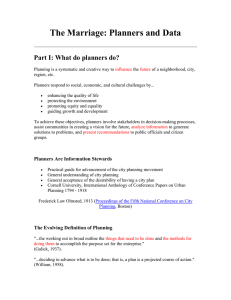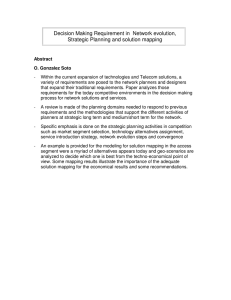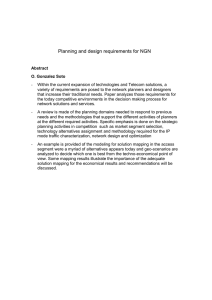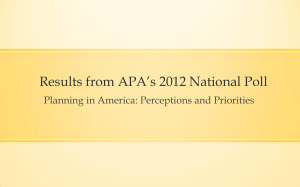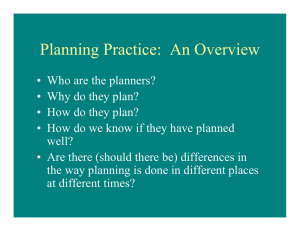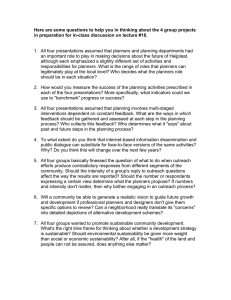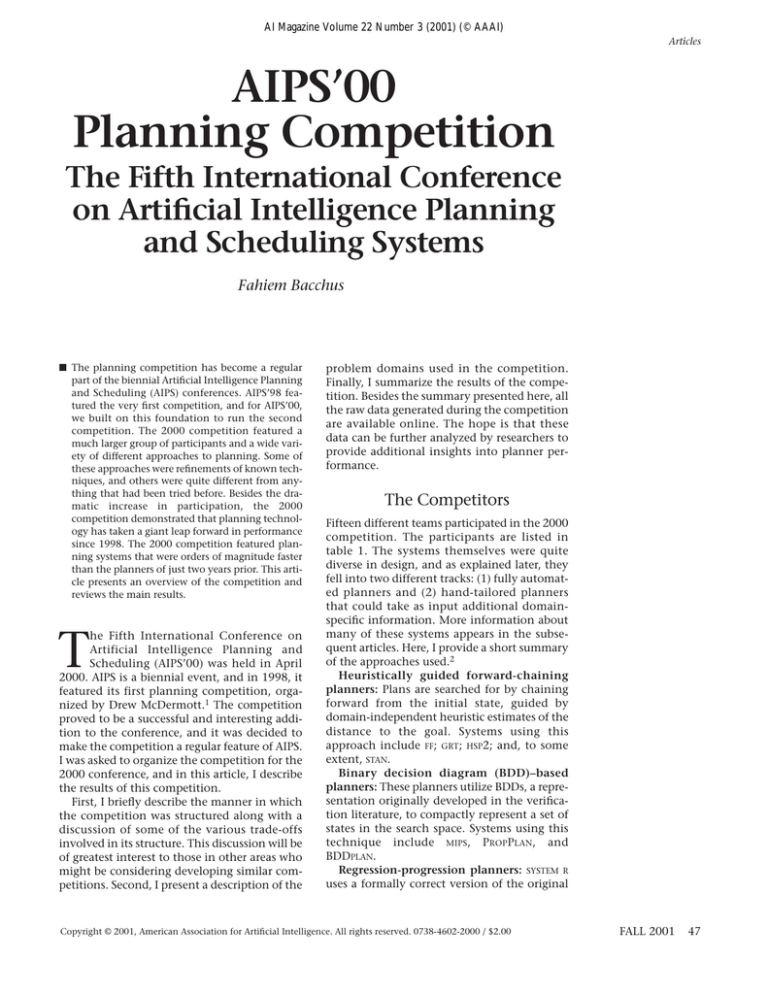
AI Magazine Volume 22 Number 3 (2001) (© AAAI)
Articles
AIPS’00
Planning Competition
The Fifth International Conference
on Artificial Intelligence Planning
and Scheduling Systems
Fahiem Bacchus
■ The planning competition has become a regular
part of the biennial Artificial Intelligence Planning
and Scheduling (AIPS) conferences. AIPS’98 featured the very first competition, and for AIPS’00,
we built on this foundation to run the second
competition. The 2000 competition featured a
much larger group of participants and a wide variety of different approaches to planning. Some of
these approaches were refinements of known techniques, and others were quite different from anything that had been tried before. Besides the dramatic increase in participation, the 2000
competition demonstrated that planning technology has taken a giant leap forward in performance
since 1998. The 2000 competition featured planning systems that were orders of magnitude faster
than the planners of just two years prior. This article presents an overview of the competition and
reviews the main results.
T
he Fifth International Conference on
Artificial Intelligence Planning and
Scheduling (AIPS’00) was held in April
2000. AIPS is a biennial event, and in 1998, it
featured its first planning competition, organized by Drew McDermott.1 The competition
proved to be a successful and interesting addition to the conference, and it was decided to
make the competition a regular feature of AIPS.
I was asked to organize the competition for the
2000 conference, and in this article, I describe
the results of this competition.
First, I briefly describe the manner in which
the competition was structured along with a
discussion of some of the various trade-offs
involved in its structure. This discussion will be
of greatest interest to those in other areas who
might be considering developing similar competitions. Second, I present a description of the
problem domains used in the competition.
Finally, I summarize the results of the competition. Besides the summary presented here, all
the raw data generated during the competition
are available online. The hope is that these
data can be further analyzed by researchers to
provide additional insights into planner performance.
The Competitors
Fifteen different teams participated in the 2000
competition. The participants are listed in
table 1. The systems themselves were quite
diverse in design, and as explained later, they
fell into two different tracks: (1) fully automated planners and (2) hand-tailored planners
that could take as input additional domainspecific information. More information about
many of these systems appears in the subsequent articles. Here, I provide a short summary
of the approaches used.2
Heuristically guided forward-chaining
planners: Plans are searched for by chaining
forward from the initial state, guided by
domain-independent heuristic estimates of the
distance to the goal. Systems using this
approach include FF; GRT; HSP2; and, to some
extent, STAN.
Binary decision diagram (BDD)–based
planners: These planners utilize BDDs, a representation originally developed in the verification literature, to compactly represent a set of
states in the search space. Systems using this
technique include MIPS, PROPPLAN, and
BDDPLAN.
Regression-progression planners: SYSTEM R
uses a formally correct version of the original
Copyright © 2001, American Association for Artificial Intelligence. All rights reserved. 0738-4602-2000 / $2.00
FALL 2001
47
Articles
Team
Joerg Hoffmann, Albert Ludwigs University, Germany
Ioannis Refanidis, Ioannis Vlahavas, and Dimitris Vrakas, Aristotle University, Greece
Fangzhen Lin, The Hong Kong University of Science and Technology, Hong Kong
Stefan Edelkamp and Malte Helmert, University of Freiburg, Germany
Jana Koehler, Schindler Lifts Ltd. Switzerland; Joerg Hoffmann and
Michael Brenner, University of Freiburg, Germany
Hector Geffner and Blai Bonet, Universidad Simon Bolivar, Venezuela
Michael Fourman, University of Edinburgh, United Kingdom
Derek Long and Maria Fox, University of Durham, United Kingdom
Henry Kautz, University of Washington; Bart Selman and Yi-Cheng Huang, Cornell University
Biplav Srivastava, Terry Zimmerman, BinhMinh Do, XuanLong Nguyen, Zaiqing Nie,
Ullas Nambiar, and Romeo Sanchez, Arizona State University
Yannick Meiller and Patrick Fabiani, ONERA—Center of Toulouse, France
Hans-Peter Stoerr, Dresden University of Technology, Germany
Dana Nau, Hector Munoz-Avila, Yue (Jason) Cao, and Amnon Lotem, University of Maryland
Jose Luis Ambite, Craig Knoblock, and Steve Minton,
University of Southern California Information Sciences Institute
Jonas Kvarnstrom, Patrick Doherty, and Patrik Haslum, Linkoping University, Sweden
System
FF
GRT
SYSTEM R
MIPS
IPP
HSP2
PropPlan
STAN
BLACKBOX
ALT ALT
TOKENPLAN
BDDPLAN
SHOP
P BR
TALPLANNER
Table 1. The Competitors.
regression-progression algorithm of STRIPS.
GRAPHPLAN-based planners: IPP and, to some
extent, STAN base their planners on GRAPHPLAN.3
SAT -based planners: BLACKBOX operates by
converting a planning problem to a satisfiability problem and then applies SAT-solver technology.
Petri net planners: TOKENPLAN uses a novel
approach that uses colored Petri nets.
Hierarchical task network (HTN) planners: SHOP is an HTN planner that uses a novel
left-to-right plan-elaboration scheme.
Plan rewriting: PBR takes the output of a
simple, low-quality planner and rewrites the
plan to produce a better plan.
Temporal logic search control: TALPLANNER
uses the TLPLAN approach to planning,4 where
additional domain-specific control is specified
using a temporal logic. These logical expressions are used to prune the search space while
a plan is being searched for.
The Competition’s Structure
The guiding principle of the AIPS competition
is to be as inclusive as possible, start slow, and
develop and expand the range of the competition as time goes on. The first competition,
held in 1998, had two separate tracks and a
total of five competitors. Building on this foundation, organizers were able to attract 15 competitors to the 2000 competition. Clearly, the
48
AI MAGAZINE
first competition had served to pique interest
in the research community. In the 1998 competition, an attempt was made to include HTNstyle planners in a separate track. Such planners
use
additional
domain-specific
information, information that goes well
beyond the simple specification of the primitive actions used in domain-independent planners.5 A serious attempt was made to supply a
precise specification of the input such planners
could take. However, the resulting specification
was complex, and it would have been time
consuming to adapt existing HTN planners to
it. Another difficulty was that the specification
only addressed the HTN style of supplying
additional domain-specific information.
In the 2000 competition, I decided to go a
different direction. In particular, I am convinced by my own work in planning that
domain-specific information must be used if
we want to reach the next level of planning
performance; so, I felt it was important to
include planning systems that take advantage
of such information. At the same time, however, I felt that it was inappropriate to prescribe
the manner in which this knowledge should be
specified or used by a planning system. In fact,
one of the major complexities in mounting a
competition of this sort is that considerable
care must be taken to minimize building
assumptions about solution techniques into
the competition’s structure. A competition
Articles
should not prescribe how the problem is to be
solved; it should try to allow for approaches
never thought of before.
To address the problem of domain-specific
information, we allowed the planning systems
to compete in two separate tracks: (1) planners
that took as input a specification of the primitive operators in the domain only and (2) planners that could take extra domain-specific
information. Organizers made no attempt to
limit the kinds of extra information the planning systems of the second track could use; we
only required that they produce correct plans:
executable sequences of primitive actions that
achieved the goal. In particular, it would have
been possible for a competitor in the second
track to have written a special program for each
domain. None of the competitors chose to go
this route, however. Rather in this hand-tailored track, we had systems that used domainspecific heuristics, search control specified as
expressions of temporal logic, HTNs, and plan
rewriting. It is an interesting question whether
such a competition should prohibit solutions
based on programming. My personal opinion
is that such “solutions” should be permitted
but that adequate ways of evaluating planning
systems must also include some measurement
of the development time (not of implementing
the planning system but the time required to
configure it to solve a new domain). As pointed
out during one of the panels at the conference,
for commercial applications of planning, ad
hoc programs are the competition. AI technologies such as AI planning must eventually
prove themselves to be more cost effective than
writing ad hoc programs, and in practice, once
a certain minimal level of performance is
achieved, development time is probably the
most important cost measure.
During the competition, there was a relatively limited time available to the competitors to
get their system ready for a new domain. Typically, the new domain would be released, and
the competitors were given a week to produce
their results. We measured the time required to
solve the planning problems and the length of
the plan, mainly using the time required to
rank the planners. Thus, for the configurable
planners, we did not have a good measure of
development time. We hope to improve on
this in future competitions.
In general, no serious attempt was made to
measure the quality of the plans produced in
either of the competition tracks. Only the
length of the plan was measured because there
was no facility for specifying the cost of different solutions. In fact, most of the planning systems were incapable of taking such a metric
into account during planning. I believe that
the whole notion of trying to measure plan
quality is flawed unless different cost metrics
can be specified for each planning problem,
and the planning system can modify its behavior based on the supplied metric. Different situations can require radically different cost metrics; there can even be situations where longer
plans are to be preferred (for example, when
earning an hourly wage for a fixed task). Thus,
if a planning system generates the same plan
irrespective of the cost metric, any attempt to
measure the quality of the plans it produces
will yield a number that will be based entirely
on whether the planner had a lucky match
with the cost metric. This measurement is
hardly useful for judging the quality of the
plans the planner is capable of producing.
Thus, for this competition, we stayed with the
simple notion of plan length, with the caveat
that even this element should not be taken too
seriously. For the 2002 competition, there are
plans to have a track with problems involving
metric quantities, which will provide the necessary substrate to start dealing appropriately
with cost metrics.
All the test domains were specified using a
subset of the PDDL language (the exact form of
which is contained in a document stored on
the competition’s home page).6 Some of the
test domains were specified solely using STRIPS
operators, and some used the more expressive
ADL operators.7 Some of the planning systems
were not capable of handling ADL operators, so
to be as inclusive as possible, an attempt was
made to use the simplest form of operator feasible for each domain.
Organization
To run the competition, a single machine was
provided to the competitors. This machine
was located at the University of Toronto. It
was a relatively powerful workstation—a 500megahertz Intel PENTIUM III with 1 gigabyte of
random-access memory—but certainly nothing extraordinary. The competition itself consisted of five rounds, with rounds 1 through 4
being run by remote access to the machine in
Toronto. Each round consisted of a specific
problem domain, along with a suite of test
problems. A harder set of test problems were
made available for those planners in the
domain-specific track because typically these
planners are able to solve larger problems. The
domain and problem suites were released at
particular times, and the competitors were
required to produce their results within a set
time period. To make the process manageable,
the competitors were responsible for running
The guiding
principle of
the AIPS
competition
is to be as
inclusive as
possible,
start slow,
and develop
and expand
the range
of the
competition
as time
goes on.
FALL 2001 49
Articles
The
improvement
in performance
over the
two-year
period is
remarkable.
their own systems on the problem suite and
reporting their results in a particular format.
In addition, as a check against fraudulent
reporting, they were required to make available a batch file that I could run to ensure that
their system was in fact generating solutions
in approximately the times reported. I would
randomly pick a few systems after each round
and double check the reported results. I am
happy to report that there was never even a
hint of fraudulent reporting!
After the results had been submitted, we ran
the reported solutions through a plan checker.
For the most part, the plans were correct, but
on more than one occasion, incorrect plans
were detected by the plan checker. Most of
these instances arose from software
bugs—many of the systems were in a state of
continual development during the course of
the competition. The competition was
designed to illuminate the potential of alternate algorithmic approaches to planning.
Hence, a balance had to be achieved between
testing the competitor’s abilities at building
software and testing their abilities at designing
innovative solutions to the planning problem.
Thus, in each of these cases, the competitor
was given an opportunity to see if the invalid
plans arose from a simple bug in their system,
fix the bug, and rerun the test suite. If the competitor was unable to do this in a short timeframe, all the results for the domain on which
an incorrect plan was found were disqualified.
The Problem Domains
There were 5 problem domains and on the
order of 50 to 100 test problems in each
domain. The test suite contained a sequence of
problems of increasing size and complexity.
The first two domains were standard domains,
designed to help the competitors become
accustomed with the mechanics of the competition. The first domain was the standard fouroperator blocks-world domain (all STRIPS operators). The blocks world is probably the oldest AI
planning domain and has come under increasing criticism as a prototypically uninteresting
and unrealistic toy domain, something AI
should move beyond. However, in experiments
I conducted with the planners in the 1998
competition, and older planning systems, I
found that none of them were able to solve
blocks-world problems effectively. Typically,
they hit a computational cliff once they got to
problems containing 13 to 14 blocks. However,
the blocks world has a simple and natural
structure that intelligent systems should be
able to take advantage of, just as humans can.
50
AI MAGAZINE
I have no objection to discarding a toy problem
that contains no natural structure or is easy to
solve, but it seems to be scientifically unsatisfactory to discard a toy problem simply because
it is embarrassing to admit that it can’t be
solved with current techniques. This said, I am
pleased to report that now the field can in good
conscience leave the blocks world behind; as
the reader can see, many of the planners in the
2000 competition performed well on this
domain.
The second domain was the logistics world,
a domain that was used in the 1998 competition. This domain encodes a very simplified
form of logistics planning. In particular, there
are a collection of packages at various locations
in various cities. The packages can be transported between locations in the same city by
trucks and between airports in different cities
by airplanes. The goal is to move the various
packages from their initial location to a final
location. The domain contains six STRIPS operators, and its main complexity comes from the
size of the state space. On some of the larger
problems, the search space can have branching
factors as large as 1000 and required plans containing over 200 steps. This domain proved to
be hard for the systems in the 1998 competition but much easier for the systems in the
2000 competition. The improvement in performance over the two-year period is remarkable.
The third domain was the schedule world, a
simplified machining domain. The domain
consists of nine machining operators that do
things such as paint, grind, and drill an object.
The goal is to transform some collection of
objects by performing various machining operations on them. Some operations destroy the
effects or preconditions of other operations; for
example, grinding destroys the paint on an
object, and rolling an object makes it hot, after
which there is no way to polish it. Furthermore, the domain has a simple notion of time:
An object cannot be operated on by two different machines at the same time, and a machine
cannot operate on two different objects at the
same time. A correct plan has to sequence these
operations in the right way and account for the
resource constraints. Most of the operators in
this domain are ADL operators with conditional
and universal effects.
The fourth domain was an encoding of the
solitaire card game FreeCell. This free computer
game comes with every WINDOWS operating system—it has been claimed to be the world’s
most popular computer game.8 The game layout is shown in figure 1. The four squares at the
upper right are the home cells, one for each
suit. The goal is to move all the cards home in
Articles
Figure 1. The FreeCell Domain.
the order ace, two, …, King. The four squares at
the upper left are the free cells. They act as
buffers, a temporary space to hold as many as
four different cards.
The main board contains eight columns of
cards, randomly configured. In this section of
the board, only exposed cards can be moved.
They can be moved to a home cell if all previous cards are already there (for example, in figure 1 if any of A♠, A♥, A♦, or 2♣ were exposed,
they could be moved home); moved to a free
cell if there is space available; or moved in a
legal solitaire move, that is, moved on top of a
next-highest card of opposite color (for example, in figure 2, the 3♠ could be moved on top
of the 4♦, thus exposing the 10♣). This domain
was encoded using 10 STRIPS operators. Starting
with a fixed set of initial games, simpler versions of each game were generated by removing the top k cards of every suit. For example,
by removing the face cards in this configuration, we create a simpler game containing only
40 cards. The complexity of the game reduces
considerably as the number of cards is
decreased: Fewer deadlocks are created. It can
be proved that this domain contains unsolvable games, although they are relatively rare.9
The fifth and final domain was an encoding of
a sophisticated elevator controller produced by
Schindler Lifts Ltd.10 This controller, in operation in some of the world’s tallest buildings, controls a bank of elevators. Users go to a central station and punch in their floor request. The
controller then tells them which elevator they
should use. In this way, the controller attempts
to minimize the delay time by scheduling an
entire bank of elevators together instead of having each elevator run separately. The controller
also allows for various special situations, for
example, VIP users or sets of users who should
FALL 2001 51
Articles
not be riding an elevator together. The planning
domain was configured in a number of different
ways to accommodate the representational power of different planning systems.11
10000
System R
FF
HSP2
100
Seconds
Results
1
49
47
44
42
39
37
34
32
29
27
24
22
19
17
0.01
Number of Blocks
Figure 2. Fully Automated Blocks Central Processing Unit Time.
250
System R
FF
HSP2
Number of Steps
200
150
100
50
49
47
44
42
39
37
34
32
29
27
24
22
19
17
0
Number of Blocks
Figure 3. Fully Automated Blocks Plan Length.
100000
System R
PbR
TALplanner
SHOP
Seconds
1000
10
Number of Blocks
Figure 4. Hand-Tailored Blocks Central Processing Unit Time.
52
AI MAGAZINE
500
500
475
475
450
450
425
425
400
400
350
350
300
300
250
250
200
200
100
100
0.1
I present here only a summary of the main
results. A set of presentation slides are available
on the competition’s web site that contain a
number of other performance graphs. Even
more detailed information is available in a set
of EXCEL spreadsheets and a set of log files that
contain all the data collected during the competition.
In the blocks world, the problems consisted
of transforming a random configuration of N
blocks to another random configuration. In
this domain, the number of blocks was a natural measure of problem complexity. For many of
the fully automatic planning systems, 14 to 15
blocks proved to be the limit of their reasonable performance. However, there were three
fully automated systems that were able to solve
much larger problems. Figure 2 shows the time
performance of SYSTEM R, FF, and HSP2 on these
larger problems. The horizontal axis shows the
number of blocks in the problem, starting at 17
and advancing to 50. We see that SYSTEM R is a
very robust solver of blocks-world problems,
and FF and HSP2 are both able to solve large
problems but with dropouts (a missing segment
indicates that the problems of this size were
not solved). Figure 3 shows the length of the
plans generated in solving these problems (the
dropouts to zero occur when no plan is found).
We see that HSP2 sometimes generates plans
that are much longer than necessary, but FF,
which uses a similar forward-chaining technology, is able to find short plans. SYSTEM R does
well both in terms of plan length and time to
find a plan (it also has no dropouts in this
range). In this domain, it was able to generate
plans containing almost 200 steps in about 900
seconds.
The hand-tailored planners were able to
demonstrate impressive performance in this
domain: They were able to take, as input, information about the special structure of the
blocks world that makes this domain easy. The
performance of the best hand-tailored planners
on a set of much larger problems is shown in
figure 4. These planners all generated plans of
similar length, with the plans for the 500-block
problems almost 2000 steps in length. It is
worth noting that TALPLANNER was able to solve
these large problems in about 1.5 seconds. SYSTEM R in this figure is configured to use additional domain-specific heuristic information;
Articles
System R
HSP2
FF
GRT
STAN
Mips
Seconds
1000
10
41
38
36
33
31
28
26
23
21
18
16
0.1
Number of Packages
Figure 5. Fully Automated Logistics Central Processing Unit Time.
600
System R
FF
HSP2
STAN
GRT
Mips
Number of Steps
500
400
300
200
100
41
38
36
33
31
28
26
23
21
18
16
0
Number of Packages
Figure 6. Fully Automated Logistics Plan Length.
1000
System R
SHOP
TALplanner
100
Seconds
10
1
96
91
86
81
76
71
66
61
56
51
46
41
36
31
26
0.01
21
0.1
16
thus, it was able to increase its performance
significantly over its domain-independent
mode (see figure 2).
In the logistics world, the problems consist
of transporting a varying number of packages.
The number of cities, trucks, and airplanes
were increased linearly with the number of
packages, thus increasing the size of the search
space even further. The packages were randomly distributed among the possible cities
and locations in these cities in both the initial
and the goal state. In this domain, a number of
the fully automated systems were able to
achieve good performance. Figures 5 and 6
show the performance of the top six systems
on some of the larger logistics problems. We
see that except for SYSTEM R, there is very little
to choose between the other five planning systems (GRT, HSP2, STAN, MIPS, and FF) in terms of
time or plan length. FF and MIPS were the
fastest, but STAN consistently generated the
shortest plans. In this domain, plans containing more than 200 steps were being generated
in about 100 seconds.
The performance of the top three hand-tailored planners is shown in figures 7 and 8.
Again, we see that at the price of additional
domain-specific information, performance can
be increased. SHOP and TALPLANNER generate
plans of an almost identical length and significantly shorter than SYSTEM R. In terms of planning time, however, TALPLANNER has a significant edge over the other two systems.
The schedule world posed an additional difficulty for the planners. It required ADL operators. Hence, of the fully automated planning
systems, only the systems MIPS, FF, HSP2, IPP,
PROPPLAN, and BDDPLAN were able to deal with
this domain. The problems in this domain are
parameterized by the number of objects to be
machined. Each object was assigned a random
set of properties in the initial state and
required to have a random collection of new
properties in the goal state. In this domain, the
techniques used by FF were clearly superior, as
figure 9 demonstrates. The graph showing the
length of the plans is omitted because the
plans generated were all of approximately the
same length. In figure 10, the performance of
the hand-tailored planners is shown. Only
three systems were able to generate correct
plans in this domain: (1) BDDPLAN, (2) PBR,
and (3) TALPLANNER. Of them, again TALPLANNER was superior both in terms of planning
time and plan length.
The FreeCell domain as a planning problem
arose from a class project that I set in my introductory AI class. I give the students access to
my TLPLAN system and ask them to find a prob-
Number of Packages
Figure 7. Hand-Tailored Logistic Central Processing Unit Time.
FALL 2001 53
Articles
4000
System R
SHOP
TALplanner
3500
Number of Steps
3000
2500
2000
1500
1000
500
96
91
86
81
76
71
66
61
56
51
46
41
36
31
26
21
16
0
Number of Packages
Figure 8. Hand-Tailored Logistics Plan Length.
10000
FF
IPP
BDDPlan
Mips
HSP2
PropPlan
Seconds
100
1
48
45
42
38
35
32
28
25
22
18
15
12
8
5
2
0.01
Number of Objects
Figure 9. Fully Automated Schedule Central Processing Unit Time.
10000
PbR
BDDPlan
TALplanner
Seconds
100
48
45
42
38
35
32
28
25
22
18
15
8
5
2
0.01
12
1
Number of Objects
Figure 10. Hand-Tailored Schedule Central Processing Unit Time.
54
AI MAGAZINE
lem they can encode as a planning problem
(and solve by writing appropriate temporal
control logic). Invariably, they display far more
imagination at this task than I have! The FreeCell domain is one of the more interesting
domains that has arisen from these projects. As
described previously, problems were parameterized by the number of cards in each suite
and were created by reducing some standard
full-deck problems. This domain proved to be
quite challenging for the planning systems,
and interestingly, the hand-tailored planners
fared no better on it than the fully automatic
planners. In experiments, I have been able to
get my own TLPLAN system to solve all but 75 of
the 32,000 standard full-deck problems (in an
average of about 25 seconds and 100 plan steps
for each problem). However, my solution
required a fair amount of experimentation to
find a good heuristic; so, this domain does
demonstrate that the task of finding useful
domain-specific information can be difficult.
Figure 11 shows the planners’ performance in
this domain. Among the fully automatic planners, STAN, FF, and MIPS were the best performers
in terms of solution time. However, STAN did
tend to generate considerably longer plans,
and MIPS tended to generate the shortest plans.
These plans were about 125 steps long for the
full-deck problems. With the hand-tailored
planners, TALPLANNER was again the fastest
planner, but this time, it was not significantly
faster than the fastest fully automatic planner
(figure 12). Furthermore, figure 13 shows something telling about its performance in this
domain: It is generating plans that are an order
of magnitude longer then necessary (almost
5000 steps for some of the full-deck problems!).
Note that in this graph, the y-axis is in a log
scale.
I won’t include the graphs derived from the
final domain, the elevator domain; they are
available on the competition’s web site. However, it is interesting to note that for the most
part, the problems in this domain were quite
easy. The real difficulty in this domain came
from representing all the features of the
domain. The domain contained complexities
that were beyond what most of the planning
systems could represent. For this reason, various versions of the domain were created, from
a very simplified STRIPS version to a more realistic ADL version. The most complex version
included the constraint that no more than six
passengers could be on an elevator at the same
time. Only two of the systems could deal correctly with this most general version: TALPLANNER and PROPPLAN.
Articles
The Prize Winners
Seconds
13
12
11
10
9
8
7
6
5
4
3
2
Cards/Suite
Figure 11. Fully Automatic FreeCell Central Processing Unit Time.
10000
System R
SHOP
TALplanner
100
1
13
12
11
10
9
8
7
6
5
4
0.01
Cards/Suite
Figure 12. Hand-Tailored FreeCell.
10000
System R
TALplanner
SHOP
1000
100
13
12
11
10
9
8
7
6
5
4
1
3
10
2
Number of Steps
The planning competition has proved to be a
useful mechanism for furthering interest and
research in planning. It is not intended to take
the place of normal peer-reviewed research
results published in conference proceedings
and journals. In particular, there is a considerable gap between ideas worthy of publication
and notions that are ready to be used in a
robust and efficient planning system. Research
that is capable of increasing our understanding
or contributing novel ideas to the field is essential if we want to build better planning systems
2, 3, 5, or even 20 years in the future. The competition provides a useful additional test of
some of our research ideas, which if used properly can generate excitement, increase interest,
and tell us a great deal about the potential of
various approaches to the planning problem.
HSP2
GRT
0.01
Congratulations to these researchers.
Conclusion
FF
STAN
1
3
Exceptional Performance
1. FF, domain-independent planning system, Joerg Hoffman, Albert Ludwigs University, Germany
2. TALPLANNER, hand-tailored planning
system, Jonas Kvarnstrom, Patrick Doherty, and Patrik Haslum, Linkoping University, Sweden
Mips
TokenPlan
100
2
Honorable Mention
1. STAN, Derek Long and Maria Fox, University of Durham, United Kingdom
2. HSP2, Hector Geffner and Blai Bonet,
Universidad Simon Bolivar, Venezuela
3. MIPS, Stefan Edelkamp and Malte
Helmert, University of Freiburg. Germany
4. SYSTEM R, Fangzhen Lin, The Hong Kong
University of Science and Technology,
Hong Kong
BlackBox
IPP
10000
Seconds
Two separate prizes were given out, courtesy of
the Cel Corporation (CelCorp) and Schindler
Lifts Ltd. CelCorp provided some cash prizes
for performance, and Schindler Lifts provided a
prize for performance in the elevator domain.
The prize winners for this domain were FF and
TALPLANNER. The prizes for performance, however, were much more difficult to evaluate
because there was considerable variance in performance across domains. These winners
became a judgment call on my part, and I
chose two groups of planning systems; a set of
distinguished planners; and two exceptional
planners, one from each track. My selections
were as follows:
Cards/Suite
Figure 13. Hand-Tailored FreeCell Plan Length Log Scale.
FALL 2001 55
Articles
For 2000, what was especially impressive was
the stunning improvement in performance
from 1998 and the fact that quite different
techniques were being used in the best planners. Plans are proceeding for the next planning competition to be held in conjunction
with AIPS’02 in April 2002 in Toulouse, France.
Derek Long and Maria Fox are organizing this
competition, and one of its key components
will be to encompass richer models of planning, including resources and concurrency.12
Acknowledgments
Let me now turn to the important and pleasant task of acknowledging the assistance of
the people and organizations whose help was
essential in making the competition a success.
Michael Ady and Janet Droppo run a software
development company called Winter-City
Software in Edmonton, Alberta, Canada. Ady
has done most of development of the TLPLAN
planning and did a tremendous amount of
work in helping me set up the planning problems.13 He also wrote a plan checker to verify
the plans and used it to verify all the plans
generated by the competitors. Droppo developed a set of EXCEL spreadsheets that made
tracking and reporting the results feasible.
Henry Kautz, David E. Smith, Derek Long,
Hector Geffner, and Jana Koller volunteered
to be on the organizing committee that I
chaired. They provided important feedback
on various decisions that had to be made
about the competition’s structure. Franz Inc.
provided us with a copy of their ALLEGRO COMMON LISP system for the Linux system we used
to run the competition—Lisp was the implementation language used by some of the competitors. Schindler Lifts Ltd. made public the
elevator domain that was used in the competition and provided prizes for performance on
this domain. The Cel Corporation (CelCorp)
provided generous cash prizes for the top-performing competitors. John DiMarco and the
systems support staff in the Department of
Computer Science at the University of Toronto did an exceptional job of setting up and
maintaining the system used for the competition. Adele Howe did the local arrangements
for AIPS’00 and also arranged for the local
computers that were used for the final phase
of the competition at the conference site.
John-Paul Watson and Eric Dahlman set up
these computers and provided amazing support throughout the conference. Finally, last
but not least, the competitors must be
acknowledged for their willingness to undertake the sometimes stressful task of getting
their systems ready for the competition.
56
AI MAGAZINE
Notes
1. The 1998 AI Planning Systems Competition,
Drew McDermott, AI Magazine 21(2): 35–55.
2. For more information, see the subsequent
articles, and check the competition’s home
page (www.cs.toronto.edu/aips2000) for additional links.
3. For more information on IPP and GRAPHPLAN,
see The AIPS-98 Planning Competition, Derek
Long, AI Magazine 21(2): 13–34.
4. Using Temporal Logics to Express Search
Control Knowledge for Planning, F. Bacchus
and F. Kabanza, Artificial Intelligence
16:123–191.
5. For example, see A Call for Knowledge-Based
Planning, David E. Wilkins and Marie desJardins, AI Magazine 22(1): 99–115.
6. www.cs.toronto.edu/aips2000.
7. ADL operators allow for universal and conditional actions effects.
8. See www.freecell.org/ for more information
about the game.
9. An unsolvable instance of FreeCell: A Game
from Windows’95, Hans L. Bodlaender,
www.cs.ruu.nl/~hansb/d.freecell/freecellhtml.
10. Elevator Control as a Planning Problem,
Jana Koehler and Kilian Schuster, Proceedings
of AIPS’00, 331–338, Menlo Park, Calif.: AAAI
Press.
11. The complete specification of these
domains and all the test problems can be
obtained from the competition’s web site at
www.cs.toronto.edu/aips2000.
12. For up-to-date information on the upcoming competition, visit www.dur.ac.uk/d.p.long/
competition.html.
13. Using Temporal Logics to Express Search
Control Knowledge for Planning, F. Bacchus
and F. Kabanza, Artificial Intelligence 16:
123–191.
Fahiem Bacchus is a professor of computer science
at the University of Toronto. He received his Ph.D. in
1988 from the University of Alberta and spent 11
years as a faculty member at the University of Waterloo before joining the University of Toronto in 1999.
He has published on topics such as uncertainty in AI,
knowledge representation, utility modeling, learning
of Bayesian networks, nonmonotonic reasoning,
constraint-satisfaction problems, and planning. In
the area of planning, his main contribution has been
the tlplan approach to planning, an approach that
was well represented in the 2000 planning competition. Currently, his time is split between planning,
constraint satisfaction, and utility modeling. His email address is fbacchus@cs.toronto.edu.

